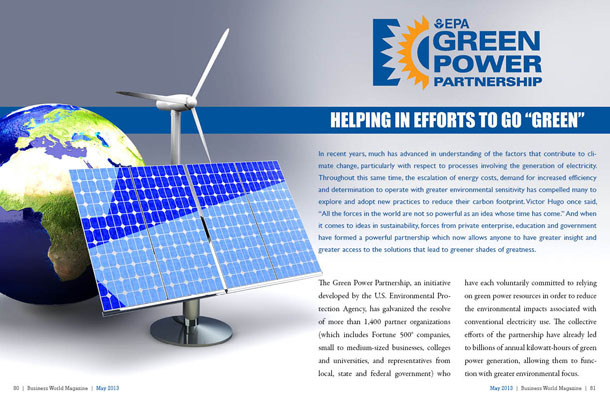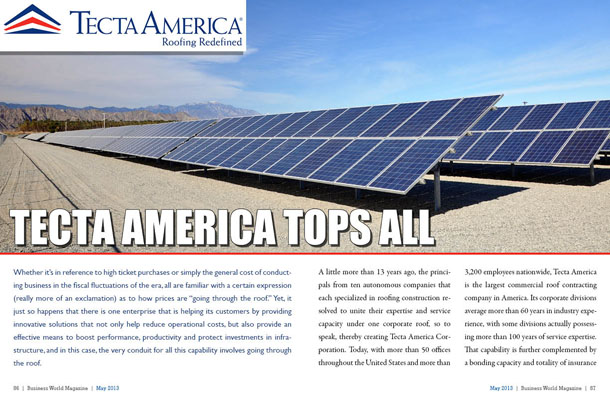
Helping in Efforts to Go “Greenâ€

In recent years, much has advanced in understanding of the factors that contribute to climate change, particularly with respect to processes involving the generation of electricity. Throughout this same time, the escalation of energy costs, demand for increased efficiency and determination to operate with greater environmental sensitivity has compelled many to explore and adopt new practices to reduce their carbon footprint. Victor Hugo once said, “All the forces in the world are not so powerful as an idea whose time has come.†And when it comes to ideas in sustainability, forces from private enterprise, education and government have formed a powerful partnership which now allows anyone to have greater insight and greater access to the solutions that lead to greener shades of greatness.
The Green Power Partnership, an initiative developed by the U.S. Environmental Protection Agency, has galvanized the resolve of more than 1,400 partner organizations (which includes Fortune 500® companies, small to medium-sized businesses, colleges and universities, and representatives from local, state and federal government) who have each voluntarily committed to relying on green power resources in order to reduce the environmental impacts associated with conventional electricity use. The collective efforts of the partnership have already led to billions of annual kilowatt-hours of green power generation, allowing them to function with greater environmental focus.
“It is exciting to see the number of stakeholders that have joined in the discussion to address climate change,†says Green Power Partnership Program Director Blaine Collison. Noting the number of participants who recently attended the 2013 Climate Leadership Conference, co-sponsored by the EPA, Collison says he is encouraged to see increasing interest and support with so many asking what they can do to help.
Collison says the Green Power Partnership emerged from the framework which led to the successful adoption of the Energy Star program. “We saw that with Energy Star, the labeling for efficiency performance had been tremendously successful … and we thought it would be possible to do something similar for the supply side,†says Collison.
To achieve energy and emission goals benefiting climate conditions, Collison says standards were developed which proposed requirements on the amount of renewable energy being utilized by participating organizations. Those rates are established on a sliding scale that is based on the respective participant’s energy consumption (minimum requirement is three percent). The program also defines which resources are considered green power, such as wind power, solar power and biomass. Members of the Green Power Partnership, companies, school systems and municipalities have increasingly incorporated the application of these renewable energy resources.
Advancing Awareness
The partnership extends an open invitation for any U.S. company or institution to join, except for sellers, suppliers, or marketers of green power. Becoming a partner involves committing to an agreement to use renewable energy in one’s operational platform. And the ability to advance in such applications is significantly easier today due to the information, resources, tools and performance models one can readily access through the Green Power Partnership. For many organizations, electricity usage is the primary source of their greenhouse gas emissions. EPA launched the partnership in 2001 to help organizations dramatically reduce these emissions by switching to green power.
In addition to providing frequent webinars, the EPA’s Green Power Partnership offers technical assistance in identifying the green power products that best meet any organization’s goals. The program provides relevant and timely answers to questions and imparts all types of information through its website. Collison says the core function of the EPA’s role in the program is to help stakeholders understand how best to connect with the solutions, peer groups, market standards and other information to achieve their goals. “Part of our job is to help participants realize they don’t have to reinvent the wheel; they can readily access the learning and expertise of others, and learn about developments that have taken place in the market… understanding what has worked, what challenges were involved, as well as what hasn’t worked,†he says.
Green Distinction
Beyond the initial technical orientation and ongoing support offered for those who join the partnership, the program also provides recognition to distinguish top performers. The EPA promotes several national- and sector-focused “Top Partner†rankings which represent the leading organizations making the largest green power purchases in the partnership (as well as those purchasing 100% green power) and the partners who generate and use the most green power on site.
Through the EPA’s annual Green Power Leadership Awards, achievements among Green Power Partners and green power suppliers are also recognized. For example, the Green Power Supplier of the Year honors utilities, retail suppliers, REC marketers, and renewable energy project developers who lead in offering voluntary renewable energy to their customers, while the Innovative Green Power Program of the Year recognizes leaders in designing and implementing innovative voluntary renewable energy offerings. There are also awards for Green Power Communities and Partners, which not only offer important encouragement for participants who are operating in an environmentally responsible manner, but also offer significant promotional means to distinguish their practices from those of their peers. Award winners for the 2013 Green Power Leadership Awards will be announced in conjunction with the annual Renewable Energy Markets Conference in Austin, Texas, on September 23, 2013.
For more details on how to join the Green Power Partnership or better benefit from the economic and environmental rewards of using renewable energy, visit the EPA’s Green Power Partnership Website at http://www.epa.gov/greenpower/.
ÂÂÂ







